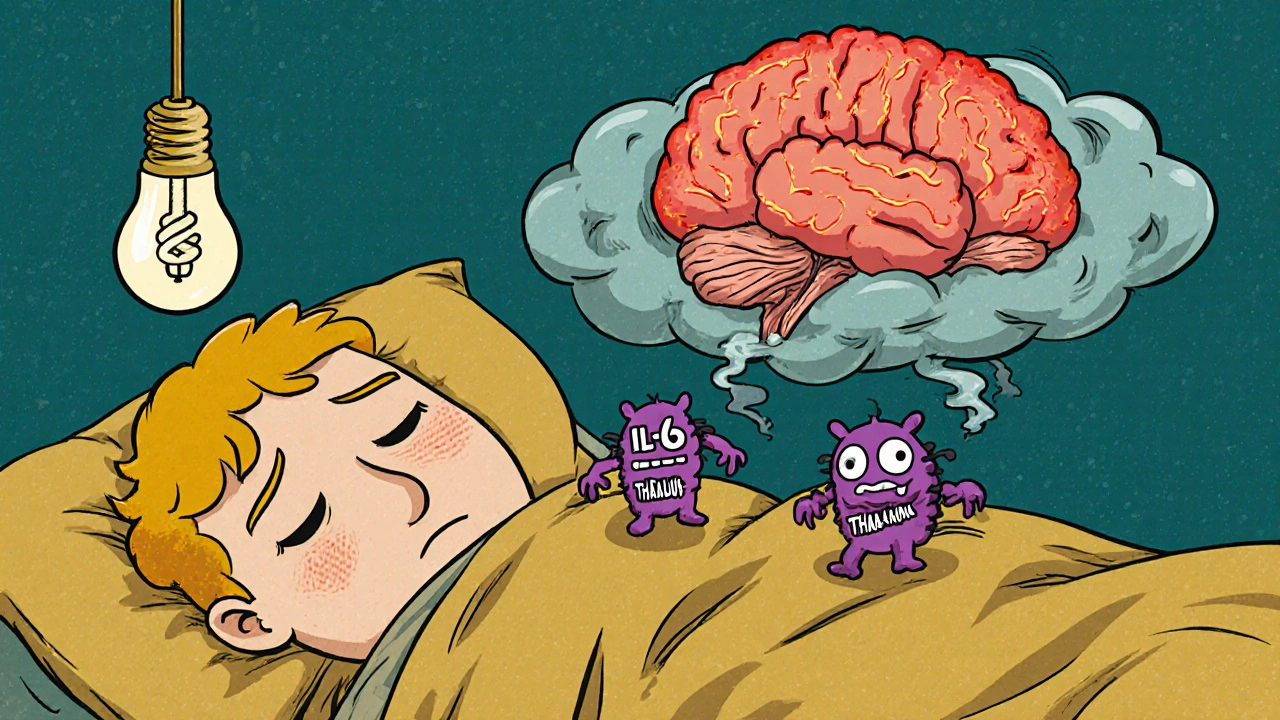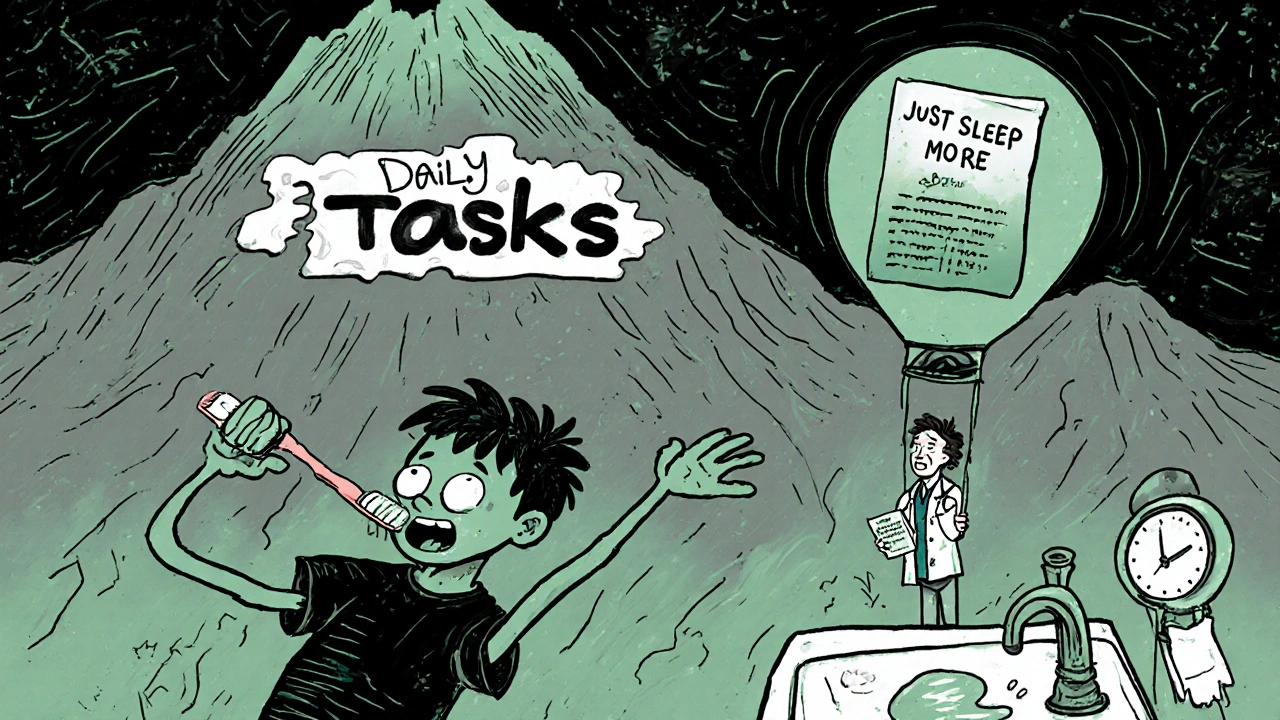 Nov, 19 2025
Nov, 19 2025
When you have an autoimmune disease, fatigue isn’t just feeling tired after a long day. It’s waking up and not being able to get out of bed. It’s sitting through a meeting and forgetting what you were saying halfway through. It’s canceling plans because even brushing your teeth feels like climbing a mountain. Fatigue isn’t a side effect-it’s the core symptom for most people with autoimmune conditions. Research shows 98% of people with diseases like lupus, rheumatoid arthritis, or multiple sclerosis live with this kind of exhaustion. And no amount of sleep fixes it.
Why Is This Fatigue So Different?
Ordinary tiredness fades after rest. Autoimmune fatigue doesn’t. It sticks around for months, even years. It flares after small efforts-like walking to the mailbox or cooking dinner-and can leave you worse for days. This isn’t laziness. It’s not depression. It’s biology. Studies using the Fatigue Severity Scale show people with autoimmune diseases score an average of 7.2 out of 10. Healthy people? Around 2.8. That gap isn’t small-it’s life-altering. Sixty-seven percent of patients score above 6, meaning their fatigue is severe enough to stop them from working, parenting, or even showering without needing to lie down afterward. What makes it worse is that doctors used to think it was all in your head. In the 1980s, fatigue in lupus and RA patients was often labeled as stress or anxiety. Now we know better. Brain scans show inflammation in areas that control energy, mood, and motivation. Blood tests reveal cytokines like IL-6 and TNF-alpha are 2.3 to 3.7 times higher than normal. These are inflammatory signals that directly mess with your brain’s ability to feel alert or motivated.The Real Culprits Behind the Exhaustion
There are three big biological drivers behind this fatigue-and they don’t always show up in standard blood tests. First, neuroinflammation. Inflammatory proteins cross the blood-brain barrier and activate microglia, the brain’s immune cells. This isn’t just swelling-it’s a constant low-grade alarm in your nervous system. MRI studies show 82% of patients with severe fatigue have visible inflammation in the hypothalamus and thalamus, areas that regulate sleep, energy, and stress. Second, HPA axis dysfunction. Your adrenal glands are supposed to release cortisol when you need energy. But in autoimmune disease, the system that controls cortisol gets damaged. Studies show a 18-22% drop in the morning cortisol spike. That means your body can’t ramp up energy properly when you wake up-or respond to stress at all. Some patients have antibodies attacking their own adrenal tissue. Third, mitochondrial dysfunction. Mitochondria are your cells’ power plants. In 65% of autoimmune fatigue cases, they’re running on fumes. Muscle biopsies show 40-55% less ATP (the energy molecule) production. That’s why even small tasks leave you drained-you’re literally running out of fuel. And here’s the twist: your disease activity score doesn’t always match your fatigue level. Someone with mild RA might be exhausted, while someone with active disease feels okay. That’s because fatigue has its own pathway, separate from joint damage or organ involvement.Which Autoimmune Diseases Hit Hardest?
Fatigue isn’t equal across conditions. Some hit harder than others:- Systemic lupus erythematosus (SLE): 98% report severe fatigue
- Multiple sclerosis (MS): 96%
- Rheumatoid arthritis (RA): 94%
- Sjögren’s syndrome: 92%
- Celiac disease: 90%
- Type 1 diabetes: 88%

How Do You Measure It?
Doctors need tools to see what you’re feeling. Standard blood work won’t cut it. Here’s what’s used in clinics and research:- Multidimensional Fatigue Inventory (MFI-20): A 20-question survey. A score above 18.7 means clinically significant fatigue.
- FACIT-F (Functional Assessment of Chronic Illness Therapy-Fatigue): Scores below 34.5 indicate severe fatigue.
- Visual Analog Scale (VAS): You mark a line from 0 (no fatigue) to 10 (worst ever).
What Actually Helps? Evidence-Based Strategies
There’s no magic pill-but combining a few proven methods can make a huge difference. 1. Pacing, Not Pushing The biggest mistake? Doing too much on a good day, then crashing for days. Pacing means breaking tasks into tiny chunks and resting before you hit your limit. If you can walk for 10 minutes before fatigue hits, stop at 7. That’s not weakness-it’s strategy. Studies show 78% of patients who use pacing report better energy control. 2. Sleep That Actually Restores You Fixing sleep isn’t just about hours-it’s about quality. Many patients have disrupted circadian rhythms. Melatonin secretion is 37% lower than normal. Try these:- Wake up and go to bed at the same time every day-even weekends
- Get 15 minutes of sunlight within 30 minutes of waking
- Use blackout curtains and avoid screens 90 minutes before bed
- Treat sleep apnea or restless legs if present
- Low-dose hydrocortisone (10-20 mg/day): Helps if your cortisol is low. Shows 35-40% improvement in those with HPA axis damage.
- Modafinil: Used in MS-related fatigue. 28% better than placebo.
- CoQ10 (200 mg/day): Supports mitochondria. Shows 29% improvement in energy scores.
The Best Approach: Integrated Care
The most successful patients don’t rely on one thing. They combine:- Medication (if needed)
- CBT-AF
- Pacing and energy management
- Sleep hygiene
- Gentle movement

What Doesn’t Work (And Why)
Don’t waste time on these:- Just “sleep more”-you’re already trying.
- Extreme diets or detoxes-no strong evidence they reduce autoimmune fatigue.
- Pushing through exhaustion-this leads to longer crashes.
- Assuming it’s all in your head-your body is sending real signals.
What’s Coming Next?
Research is accelerating. The NIH just funded $18.7 million for fatigue-specific studies. Early trials with anti-IL-6 drugs (like tocilizumab) show 38% fatigue reduction in RA patients. Transcranial magnetic stimulation (TMS) is helping people with treatment-resistant fatigue. CoQ10, vitamin D, and omega-3s are being tested in larger trials. By 2026, we may see the first FDA-approved treatment specifically for autoimmune fatigue. But until then, the tools we have now-pacing, sleep, CBT, and gentle movement-are powerful.Final Thought: This Is Real. And You’re Not Alone.
On Reddit’s r/Autoimmune community, 87% of 1,200 people said fatigue was their hardest symptom. Seventy-six percent said doctors dismissed it early on. But you’re not imagining it. The science is clear: your fatigue is biological, measurable, and treatable. Start small. Track your energy. Find one strategy that works-even if it’s just resting after lunch. You don’t need to fix everything at once. Progress isn’t about being “better.” It’s about having more moments where you feel like yourself.Is autoimmune fatigue the same as regular tiredness?
No. Regular tiredness improves with rest and sleep. Autoimmune fatigue is persistent, doesn’t improve with rest, often worsens after minimal activity, and can last for months or years. It’s linked to inflammation, mitochondrial issues, and brain changes-not just lack of sleep.
Why doesn’t my doctor take my fatigue seriously?
Many doctors still view fatigue as a vague symptom rather than a measurable medical condition. Only 12% of rheumatologists use validated fatigue scales. Bring printed copies of the MFI-20 or FACIT-F questionnaires to your appointment. Ask if your fatigue score has been tracked over time.
Can exercise make autoimmune fatigue worse?
Yes-if it’s too intense or done too fast. Pushing beyond your limits can trigger post-exertional malaise, making symptoms worse for days. The key is graded, gentle movement: start with 2-5 minutes, increase slowly, and stop before exhaustion. Walking, stretching, or tai chi are safer than high-intensity workouts.
Are supplements like CoQ10 worth trying?
Yes, for some people. CoQ10 supports mitochondrial function, and studies show a 29% improvement in fatigue scores at 200 mg per day. It’s generally safe, but talk to your doctor first, especially if you’re on blood thinners or thyroid medication.
How long does it take to see improvement in fatigue?
It varies. Some notice small changes in 2-4 weeks with better sleep or pacing. For CBT-AF or exercise programs, it typically takes 3-6 months to see significant improvement. Fatigue doesn’t fix overnight-but consistent, small steps lead to lasting change.
Is there a blood test for autoimmune fatigue?
Not yet. But high levels of IL-6, TNF-alpha, and low cortisol can point to biological causes. Researchers are working on biomarkers to predict fatigue severity. For now, tracking your symptoms with validated scales (like FACIT-F) is the most reliable way to measure it.
